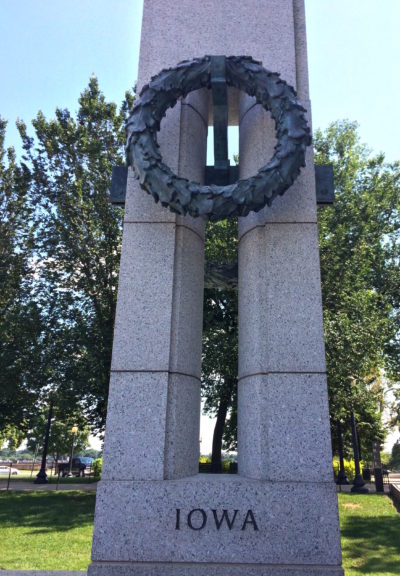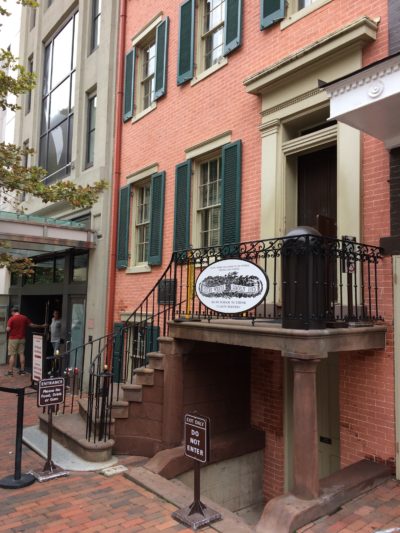


The National World War II Memorial, a painting of Herbert Hoover at the National Portrait Gallery and the House Where Lincoln Died in Washington, D.C. Photos by Michael Swanger
By Michael Swanger
Like most people, I try not to think about work during vacation. Seemingly, however, I am pleasantly reminded of it when I embark on one.
Such was the case when my wife, teenage son and I spent our family vacation this summer in Washington, D.C. Granted, our nation’s capital is replete with history, but rarely has a destination beyond Iowa’s borders provided so many historical connections to it.
Our jam-packed days were devoted to visiting as many iconic historical attractions as possible on the National Mall, or museums operated by the Smithsonian Institution and beyond. They included stops at memorials for George Washington, Abraham Lincoln, Thomas Jefferson, Martin Luther King, Jr., World War II and Vietnam veterans, as well as the National Archives, National Museum of American History, National Portrait Gallery, National Air and Space Museum and National Museum of the American Indian. We also visited the U.S. Capitol, the White House, Ford’s Theatre, Arlington National Cemetery, Union Station and walked by numerous important buildings like the U.S. Supreme Court and U.S. Department of Agriculture. Still, as anyone who has traveled there knows, we merely scratched the surface of attractions to see in Washington, D.C.
Along the way, we encountered links to our home state’s history.
Omnipresent were remembrances of duty, honor, courage and sacrifice made by the men and women of our military, as well as civilians. War memorials reminded me of my relatives who served in the military and Iowa veterans I have interviewed. So, too, did Arlington National Cemetery, located across the Potomac River from Washington, D.C. There, I saw the final resting place of my aunt who grew up in Iowa and the neighboring gravesite of a fellow Iowan, which my aunt decorated out of respect for her home state before she died.
Our tour of Ford’s Theatre included the building across the street known as the “House Where Lincoln Died.” Inside, the bedroom where Lincoln died on April 15, 1865, has been preserved. Though he was not mentioned on the tour, I was reminded of Iowa Gov. William Milo Stone, who helped carry Lincoln’s body from Ford’s Theatre across the street to the former boarding house following the president’s assassination. Stone also rode the train that transported Lincoln’s body to Springfield, Ill., and was a pallbearer at the president’s funeral.
In the National Portrait Gallery, I gazed at paintings of West Branch native and 31st President of the United States Herbert Hoover; Gen. Zachary Taylor, whose final victory and name live on Buena Vista and Taylor counties; and George Catlin’s portraits of Black Hawk and the wife of Sac and Fox leader Kee-o-kuk, two American Indians whose legacies are key pieces of Iowa history.
I thought of the 33rd Vice President of the U.S. Henry Wallace while passing the U.S. Department of Agriculture and U.S. Department of Commerce buildings, as well as the Wright Brothers and Amelia Earhart, aviation pioneers who lived in Iowa during their childhood years and whose exhibits I witnessed at the National Air and Space Museum. While visiting Capitol Hill, I was reminded of Dr. Norman Borlaug, whose statue appears inside Statuary Hall. Outside, at Capitol Square, the Sullivan Brothers Memorial Trees — originally planted in 1952 and replanted in 2008 — stand as a tribute to the ultimate sacrifice that the five Waterloo men made during World War II.
Our vacation invigorated me and my work like no other. It also reinforced my belief that Iowa history abounds, even when and where you least expect it.
TO READ MORE FASCINATING STORIES ABOUT IOWA HISTORY, subscribe to Iowa History Journal. You can also purchase back issues at the store.
